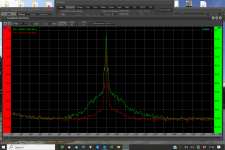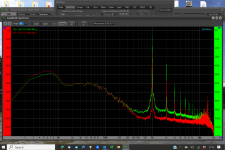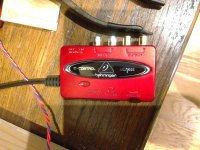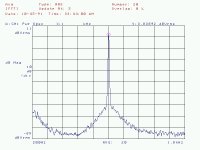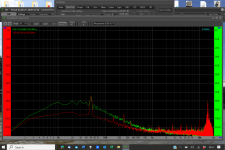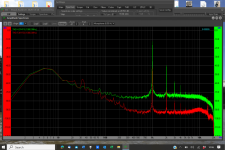Hi Sether, pleased you found it interesting.
Yes, the stylus is now between the rails, in previous versions it was under them 9and they were closer together) and that meant the height of the rails had to be at least the cartridge plus cueing allowance above the disc, so now i can lower it as much as practical. alternative rail construction might gain a few more mm......
The counterweight perpendicular to the rails is to get COM in the right place perpendicular to the rails. I will make a lighter back runner for the carriage at some point and may solve that problem and remove the CW, however it allows adjustment at the moment, including for the weight of different cartridges, but i think that will go away as well if i lighten the whole of the rear carriage runner as i am currently thinking.
There are many things i could do better, but i feel it's fundamental geometry and mechanics is working well.
M
Yes, the stylus is now between the rails, in previous versions it was under them 9and they were closer together) and that meant the height of the rails had to be at least the cartridge plus cueing allowance above the disc, so now i can lower it as much as practical. alternative rail construction might gain a few more mm......
The counterweight perpendicular to the rails is to get COM in the right place perpendicular to the rails. I will make a lighter back runner for the carriage at some point and may solve that problem and remove the CW, however it allows adjustment at the moment, including for the weight of different cartridges, but i think that will go away as well if i lighten the whole of the rear carriage runner as i am currently thinking.
There are many things i could do better, but i feel it's fundamental geometry and mechanics is working well.
M
Very clever Mike, is see as the parallelogram gets shorter (squashed) in the linear direction, this dimension gets relieved by the bearings in the vee channels. Just one question, as the stylus is moved in the vertical direction (by a severely warped LP) is there any lateral deflection observed at the stylus as it takes the force from squashing the parallelogram? This may not be visible or even noticeable?
S.
S.
Interesting question Sether!!
I have published the torture test videos before, earlier in the developments. In the combination of warp and eccentricity way in excess of any playable record which we call the torture test there is little deflection apparent.
My recent video showed a much greater range of motion than is actually used, just to demonstrate that the motion retains the cartridge orientation throughout a larger range than used and you can see in the operating range the lateral move required from the carriage is small as well. As the carriage is always on the move anyway this seems acceptable.
It is almost certain there will be some deflection, but my feeling is that with just this tiny paralelogram to move in the vertical plane the load to cause such a deflection will be smaller than in other configurations that i know of or can envisage.
By the way, earlier in developments I had the paralelogram operating at 90 degrees to this wrapped around the rails and parallel to the groove. this of course had the possibility of the stylus moving to and fro slightly parallel to the groove in warp reaction which would be a cause of effective speed change of the record relative to the stylus. in this arrangement that cannot happen.
M
I have published the torture test videos before, earlier in the developments. In the combination of warp and eccentricity way in excess of any playable record which we call the torture test there is little deflection apparent.
My recent video showed a much greater range of motion than is actually used, just to demonstrate that the motion retains the cartridge orientation throughout a larger range than used and you can see in the operating range the lateral move required from the carriage is small as well. As the carriage is always on the move anyway this seems acceptable.
It is almost certain there will be some deflection, but my feeling is that with just this tiny paralelogram to move in the vertical plane the load to cause such a deflection will be smaller than in other configurations that i know of or can envisage.
By the way, earlier in developments I had the paralelogram operating at 90 degrees to this wrapped around the rails and parallel to the groove. this of course had the possibility of the stylus moving to and fro slightly parallel to the groove in warp reaction which would be a cause of effective speed change of the record relative to the stylus. in this arrangement that cannot happen.
M
Just throwing this out there! Is there any parallelogram which can operate solely in the z axis without altering tracking force?
S.
S.
Roberval claims the invention, info easily found on the internet. i just borrowed it from Little Casey.
We use only one half of his balance but with good geometry of the counterweight etc VTF varies minutely (in the hundredths only) on this arrangement throughout the usable range ........sorry i didn't do a video of that but i will do one next time its all in pieces.
Clearly one half is a Roberval balance and the other a simple lever so with experimentation one could have no change, increase or decrease of VTF with warp movement.
Appreciate the "likes" folks
M
We use only one half of his balance but with good geometry of the counterweight etc VTF varies minutely (in the hundredths only) on this arrangement throughout the usable range ........sorry i didn't do a video of that but i will do one next time its all in pieces.
Clearly one half is a Roberval balance and the other a simple lever so with experimentation one could have no change, increase or decrease of VTF with warp movement.
Appreciate the "likes" folks
M
A pivoting arm with low COG will vary VTF, how significantly depends on how low the COG is below the pivot point. This is almost every unipivot tonearm. If VTF varies less than a 100mg then I'd call that good as long as VTF doesn't decrease as the stylus moves up this indicate COG is above the pivot, not good.Just throwing this out there! Is there any parallelogram which can operate solely in the z axis without altering tracking force?
S.
Is that it? - job done?
Meanwhile I am doing some refinements to the construction and the geometry.
M
By the way, I used a new test record and saw the attached 1Khz tone measurements. i think a lot of the noise floor was on my old test record.
- No more unfavourable levers on a linear tracker, at last.
- The orientation of the cartridge to the groove remains consistent in all respects, like the cutter head.
- Zero torque on the horizontal motion (due to the radial rail) and
- almost zero on the vertical one too (a residual issue on my previous realisations seen in these pages) and
- truly linear movements on both articulations and
- greater V / H eff. mass coherence, for free.
- All this constructed from inexpensive materials
- all achievable in the average garage workshop with hand-tools, no lathe, not even a pillar drill, but these might help improvements!
Meanwhile I am doing some refinements to the construction and the geometry.
M
By the way, I used a new test record and saw the attached 1Khz tone measurements. i think a lot of the noise floor was on my old test record.
Attachments
Very impressive Mike! I guess improvements are now in material choices, bearing contact finishes, rail stiffness, parallelogram miniaturisation perhaps. But really you are there!! I’m new to this test measurement thing, what software/hardware do you recommend?
S.
S.
Quote what you say, Mike: a great result/improvement - my congrats
What does everyone interested .... in this field think?
That it's interesting to note - from evident measures too - that linear trackers had still a decisive margin of improvement in their basic design itself. not just in materials or building accuracy
carlo
What does everyone interested .... in this field think?
That it's interesting to note - from evident measures too - that linear trackers had still a decisive margin of improvement in their basic design itself. not just in materials or building accuracy
carlo
Hi Sether, when I first was advised to measure things by a couple of friends I was doubtful.Very impressive Mike! I guess improvements are now in material choices, bearing contact finishes, rail stiffness, parallelogram miniaturisation perhaps. But really you are there!! I’m new to this test measurement thing, what software/hardware do you recommend?
S.
First, I wasn't sure i could do it, and then, why did I need to do that when i had ears!
Anyway, i soon taught myself a lesson there. Ears can easily deceive you! - and i don't have golden ears anyway.....
Every time i modified something it sounded better, well of course it did, why would i have modified it to sound worse?
Auto suggestion tells you that and you really believe it sounds better until you measure it and its clear the performance is worse, and it goes in the bin, and hopefully you learn something!
Then there are the small things you do that maybe you don't hear alone but could add up, so i am now a convicted measurer!
I would like to work out the small sideband at about -45DB if i could but have struggled to find the cause.
And its really easy;
Unplug the phono pre leads from the input to the amp and plug them into an ADC, i was advised and use a Behringer, pic attached, USB connection and power.
Load Visual Analyser on your PC and play a 1000Hz test tone into it, from your test record.
Someone kindly wrote a tutorial for me which i will dig out if folk are interested.
Attachments
@Mike56 I have been thinking about your 20Hz issue and here's my recommendation to diagnose it.
First I would isolate what is NOT causing it there is no guarantee that this is caused by the arm. It could be environmental or even the TT.
Looking at 2087 there doesn't seem to be a pounced signal at around 20Hz so the approx 20Hz could be the 3rd harmonic of 6 to 8Hz which could make it an artifact of arm/cart resonance.
To start with drop the needle on a stationary LP (use an old unwanted LP) and look for the 20Hz or a derivative of being present with the same analyser settings zoom in. If there is no 6 to 8Hz or 20Hz then you are a step closer to confirming this is being induced by the arm/cart.
Next I would use an impulse response test. Drop a marble on the LP and record it in Audacity. I used a surface plate indicator base with an alligator clip to ensure I dropped the marble in the same place on the LP from the same height. NOTE: Audacity's built in spectrum analyser does not have the resolution so use a different analyser to inspect the results. You want to inspect the results in both the time and frequency domain.
Also be aware that you are working at the lower limit of the test setup anything under 20Hz could be unreliable,. Perform each test multiple times and look for both consistencies and inconsistencies between each test, any test that falls too far from the expected result disregard. If you run each test 10 times you should have a Gaussian distribution of the results.
First I would isolate what is NOT causing it there is no guarantee that this is caused by the arm. It could be environmental or even the TT.
Looking at 2087 there doesn't seem to be a pounced signal at around 20Hz so the approx 20Hz could be the 3rd harmonic of 6 to 8Hz which could make it an artifact of arm/cart resonance.
To start with drop the needle on a stationary LP (use an old unwanted LP) and look for the 20Hz or a derivative of being present with the same analyser settings zoom in. If there is no 6 to 8Hz or 20Hz then you are a step closer to confirming this is being induced by the arm/cart.
Next I would use an impulse response test. Drop a marble on the LP and record it in Audacity. I used a surface plate indicator base with an alligator clip to ensure I dropped the marble in the same place on the LP from the same height. NOTE: Audacity's built in spectrum analyser does not have the resolution so use a different analyser to inspect the results. You want to inspect the results in both the time and frequency domain.
Also be aware that you are working at the lower limit of the test setup anything under 20Hz could be unreliable,. Perform each test multiple times and look for both consistencies and inconsistencies between each test, any test that falls too far from the expected result disregard. If you run each test 10 times you should have a Gaussian distribution of the results.
Here is my TT for reference.
One interesting thing to note is that VA shows the TT running slow but my HP 5316B frequency counter says the TT is running 0.6% fast.
Also note the difference in the base of the plots, this will be artifacts on the LP.
1st plot is The Ultimate Analog Test LP Track 2 and the 2nd is Vinyl Check Part 4, both show the same channel.
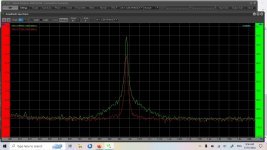
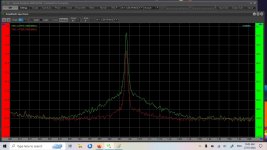
One interesting thing to note is that VA shows the TT running slow but my HP 5316B frequency counter says the TT is running 0.6% fast.
Also note the difference in the base of the plots, this will be artifacts on the LP.
1st plot is The Ultimate Analog Test LP Track 2 and the 2nd is Vinyl Check Part 4, both show the same channel.


Fascinating insights and information Warren,
Thanks so much for posting.
I will start working with those and see what i can find, i will post results, good or bad as they turn up!
M
Whilst my image 2084 appears to show the TT is spot on for speed, 1Khz =1Khz, i guess you are saying this may in fact not be the case due to software and measuring errors? - i am not looking for problems that don't exist so i shall concentrate on those little sidebands half way down. they have been present with previous versions of the arm as well........
Thanks so much for posting.
I will start working with those and see what i can find, i will post results, good or bad as they turn up!
M
Whilst my image 2084 appears to show the TT is spot on for speed, 1Khz =1Khz, i guess you are saying this may in fact not be the case due to software and measuring errors? - i am not looking for problems that don't exist so i shall concentrate on those little sidebands half way down. they have been present with previous versions of the arm as well........
A wonderful hobby this, i read Warrens useful input and, Warren i took some measurements feeling sure i could interpret something.
Unfortunately all it taught me is how little i understand.............
First, disc stationary, stylus off disc
Second, disc stationary, stylus on lead in track
Third, the previous full range measurement
Fourth the previous 1000Hz zoomed in
So, as Warren suggested, i should be able to work out something from this.
Does it tell me the sought after sideband, apparent in the fourth shot is created when the TT is switched on or from the arm when its tracking the 1000Hz, also with the TT switched on.............is it the arm, is it the TT
M
Unfortunately all it taught me is how little i understand.............
First, disc stationary, stylus off disc
Second, disc stationary, stylus on lead in track
Third, the previous full range measurement
Fourth the previous 1000Hz zoomed in
So, as Warren suggested, i should be able to work out something from this.
Does it tell me the sought after sideband, apparent in the fourth shot is created when the TT is switched on or from the arm when its tracking the 1000Hz, also with the TT switched on.............is it the arm, is it the TT
M
Attachments
@Mike56, my first question is why do you have a difference in level between channels under 1kHz with nothing playing. Swap the inputs to the Behringer if it stays the same the issue is in the Behringer or VA. I don't use VA much but I do know it has customisable filters, make sure these are all bypassed.
There are small 10, 20 30Hz peaks on 2098 are these the cause of your 20Hz sideband? it's not possible to say for sure. Switch the TT off and see what happens to these peaks.
Then I would excite the arm/cart with an impulse so see what happens. You will need to record these impulses with Audacity, just viewing in VA is insufficient.
With the stylus off the LP tap various parts of the arm structure,
With the Stylus on a stationary LP drop a marble on the LP.
I would take a minimum of 5 samples of each test then average them. If you export the Audacity files as audio you can import them into REW which has the capability to average the individual traces. The reason we take multiple samples and average them is that many samples of a test averaged will come close to the actual result. The more samples the closer to the actual result we will get. This averages out any erroneous errors.
Unfortunately you are past simple testing to make improvements. There are more things happening in the playback chain than a simple 1kHz test tone is going to tell you. From here on you will be on another learning curve. If we do it in the forum then others can learn along the way.
There are small 10, 20 30Hz peaks on 2098 are these the cause of your 20Hz sideband? it's not possible to say for sure. Switch the TT off and see what happens to these peaks.
Then I would excite the arm/cart with an impulse so see what happens. You will need to record these impulses with Audacity, just viewing in VA is insufficient.
With the stylus off the LP tap various parts of the arm structure,
With the Stylus on a stationary LP drop a marble on the LP.
I would take a minimum of 5 samples of each test then average them. If you export the Audacity files as audio you can import them into REW which has the capability to average the individual traces. The reason we take multiple samples and average them is that many samples of a test averaged will come close to the actual result. The more samples the closer to the actual result we will get. This averages out any erroneous errors.
Unfortunately you are past simple testing to make improvements. There are more things happening in the playback chain than a simple 1kHz test tone is going to tell you. From here on you will be on another learning curve. If we do it in the forum then others can learn along the way.
Many thanks Warren, i shall take it step by step.
I have learnt so much on the forum and with outside inputs, and also realised how far to go before i could say i understand anything much, so if i can contribute to learning for others that will be fantastic!
It will be great to take that journey with support from you and anyone else who contributes!
M
I have learnt so much on the forum and with outside inputs, and also realised how far to go before i could say i understand anything much, so if i can contribute to learning for others that will be fantastic!
It will be great to take that journey with support from you and anyone else who contributes!
M
That would be most helpful Warren, I’ve ordered a behringer, the same one which Mike pictured. Are all test LPs the same or is there one particular version that I should get hold of? I see that they range from £5 - £50 second hand to new. The knowledge that you guys have is incredible and any guidance as how to interpret the data would be greatly appreciated.
S.
S.
- Home
- Source & Line
- Analogue Source
- DIY linear tonearm
